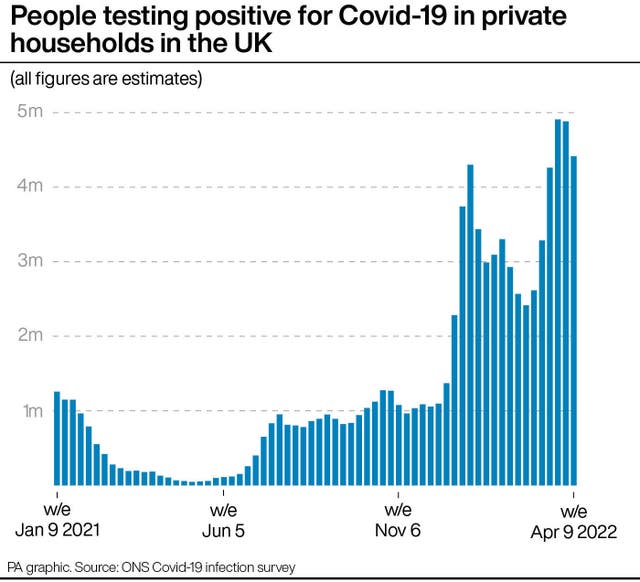Covid-19 infection levels fall across most of the UK
It is too soon to know if numbers are on a clear downwards trend, say experts.

Covid-19 infections have fallen across most of the UK, though levels in Wales remain at a record high, figures show.
England has seen infections drop for the first time in six weeks, with 3.8 million people likely to have had coronavirus last week, or around one in 14.
This is down from 4.1 million the previous week, or one in 13, according to the Office for National Statistics (ONS).
Scotland and Northern Ireland have also seen levels fall.
But in Wales infections have risen for the sixth successive week, with 231,900 people estimated to have had Covid-19 last week, or one in 13 – up slightly from 230,800, also one in 13.

Prevalence of the virus remains high across the country, the ONS said.
A total of 4.4 million people in private households in the UK were likely to have had coronavirus in the seven days to April 9.
This is down week-on-week from 4.9 million, which was the highest total since estimates began.
The fall suggests the recent surge in the virus, driven by the Omicron BA.2 variant, may have passed its peak.
It is too soon to know if infections are on a clear downwards trend.
There is still variation between different areas of the country.
While Wales continues to experience record levels of infections, Scotland has seen its numbers drop for the third week in a row.
Some 314,800 people in Scotland were estimated to have had the virus last week, or around one in 17.
This is down from 396,800 people, or one in 13, the previous week.
In Northern Ireland, 95,900 people were likely to have had Covid-19 last week, or one in 19, down from 113,900 people, or one in 16.
There is also a contrasting picture across England.
Infection levels are estimated to have fallen in eastern England, London, the North West, South East and South West, but have continued to increase in the North East, while the trend in all other regions is “uncertain”.
Professor Kevin McConway of the Open University called the figures “encouraging” but warned there were also “continuing reasons for some concern”, particularly the high levels of virus circulating in England and Wales.
Infections in England “could have fallen because the peak has been passed, but a fall lasting only one week doesn’t define a continuing trend,” he said.
“Covid-19 hasn’t gone away, and infections are still common.
“Yes, there are no legal restrictions in England, and few elsewhere in the UK. We do have to learn to live with the virus – but that doesn’t mean ignoring it.
“Let’s all please take sensible personal precautions that reduce the chance of getting infected and passing the infection on, as we enjoy the Easter holidays.”
Separate figures published on Thursday showed the hospital admission rate for people with Covid-19 in England has fallen for the first time since the end of February.
Admissions stood at 18.9 per 100,000 people in the seven days to April 10, according to the Health Security Agency.
This is down week-on-week from 21.3 per 100,000, which had been the highest rate since early 2021.
The total number of patients in hospital with Covid-19 has levelled off in recent days at roughly the level reached during the original Omicron wave in January this year.
The percentage of people aged 70 and over in England testing positive for coronavirus remains at a record of 7.2%, the equivalent of one in 14, the ONS found.
Rates among other age groups have fallen except for children from school years 7 to 11, where the trend is “uncertain”.
The ONS infection survey is the most reliable measure of the prevalence of Covid-19 in the UK.
It uses a representative sample of swab tests collected regularly from tens of thousands of households, and is therefore able to estimate the percentage of people likely to test positive for Covid-19 at any point in time, regardless of when they caught the virus, how many times they have had it and whether they have symptoms.
The survey is more representative of the level of Covid-19 in the UK than the number of cases announced each day by the Government, which includes only those who have reported themselves as testing positive, so it is affected by how many people are able to take a test or know they have symptoms.
The latest ONS figures suggest just one in eight people newly infected with Covid-19 is currently being included in the Government total.





